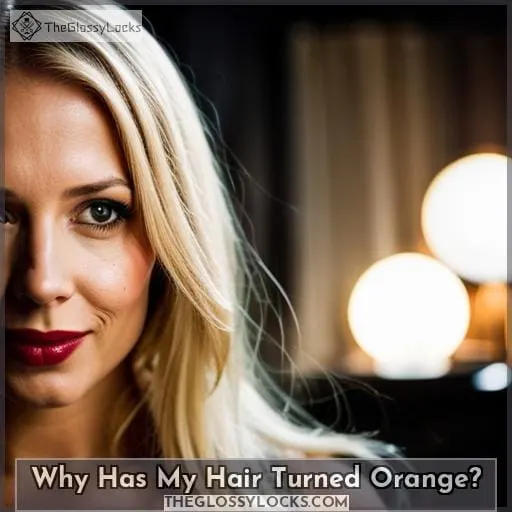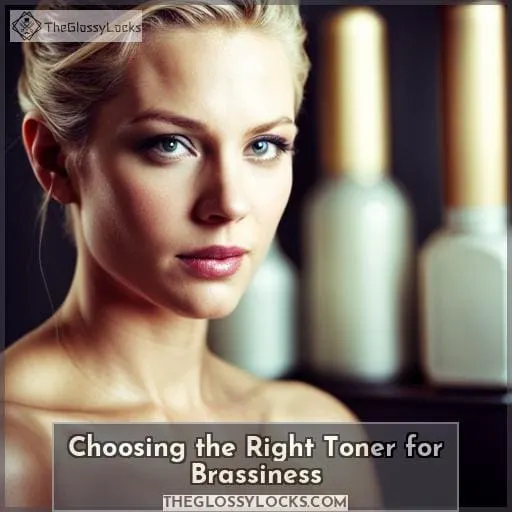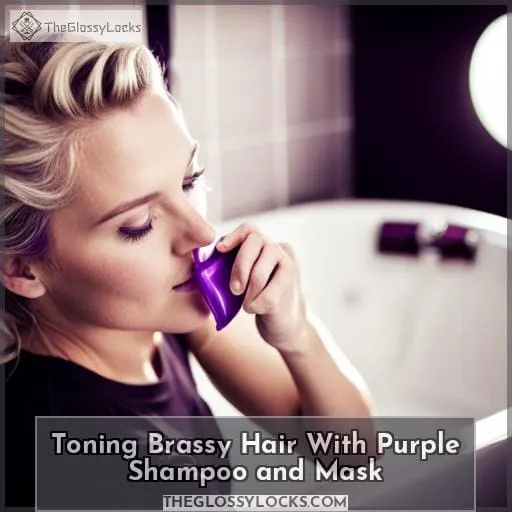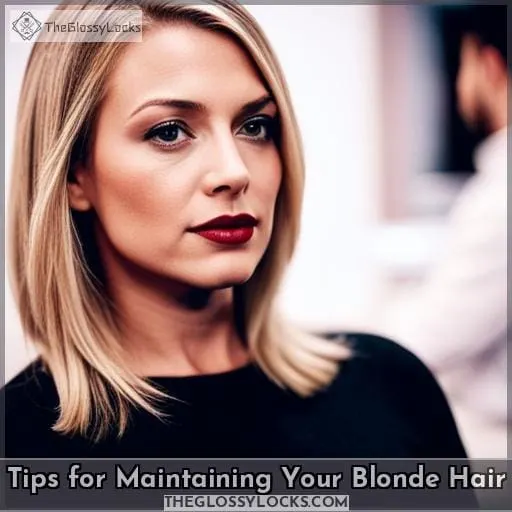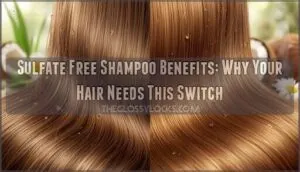This site is supported by our readers. We may earn a commission, at no cost to you, if you purchase through links.
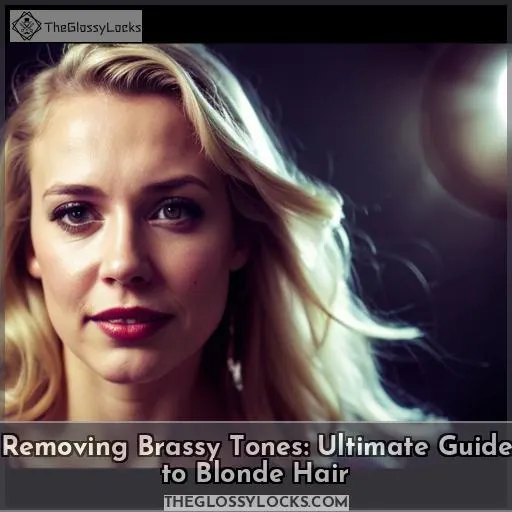
The good news is, you can easily fix brassiness and orange tones at home. Here’s a quick guide on how to remove those pesky brassy tones from blonde hair.
First things first, determine whether your hair has turned yellow or orange by examining it closely in natural light. Yellow means your hair has become warm, while orange signifies it’s become quite brassy.
The shade of brassiness indicates the type of toner you’ll need to neutralize it.
For yellow hair, use a violet-based toner. For orange-yellow hair, try an ash-based toner instead. Mix the toner with developer according to the instructions, then apply it evenly throughout your hair.
Let it process for 5-15 minutes before rinsing. Voila! Those brassy overtones will disappear before your eyes.
Table Of Contents
Key Takeaways
- Identify whether the hair is yellow or orange to determine the appropriate toner.
- Use a violet-based toner for yellow hair and an ash-based toner for orange-yellow hair.
- Consider dyeing hair a darker shade to conceal orange tones.
- Maintain blonde hair by using purple or blue shampoo, toning masks, and a white vinegar rinse.
Why Has My Hair Turned Orange?
Getting unwanted orange or brassy tones in your blonde hair can be frustrating. To remove brassy tones and achieve a cool blonde look, try purple or blue shampoo to gradually tone hair. Dyeing your hair a shade darker helps conceal orange hues, or make a salon appointment for professional lightening with toners.
Use of Purple or Blue Shampoo
You’ll want to reach for that purple shampoo to neutralize the orange and yellow tones sneaking into your blonde locks. Opt for purple shampoo twice a week at most, letting it sit for just a few minutes before rinsing.
Rotate between purple and a good moisturizing shampoo. For quicker results, use a purple hair mask weekly. Their deep pigments counteract brassiness without overdrying your hair. Don’t shampoo every day, and limit heat styling to keep your blonde bright between salon visits.
Dyeing Your Hair Darker
You’ll conceal those orange and yellow tones by dying your hair a darker shade.
- Choose a demi-permanent dye 2-3 shades darker than your current color.
- Opt for an ash or neutral tone rather than warm for best coverage.
- Perform a strand test first to ensure desired results.
- Apply toner if hair still has brassy spots after dyeing.
- Deep condition hair after dyeing to restore moisture and shine.
Salon Lightening Options
For long you’ve had bright, ashy blonde tresses. Visiting a salon for lightening provides optimal results. Expert colorists use precise bleach mixing and application for even lifting without damage. Tailored toner choices like purple shampoo banish brassiness. They recommend at-home gloss treatments, UV protection, toner masks for lasting vibrancy between appointments.
Apple Cider Vinegar Toning Rinse
A stinging concoction of fermented fruit brew restores cool hues to your locks. Let apple cider vinegar work its magic to combat brassy tones. Mix equal parts vinegar and water. After shampooing, saturate strands and let sit briefly before rinsing clean.
The acidic rinse seals the cuticle, enhancing shine and removing unwanted warm pigments. Repeat weekly for best results. Your mane emerges luminous, liberated from beastly brass.
Choosing the Right Toner for Brassiness
When toning hair to remove brassiness, it’s important to select the right shade based on your hair’s current color. For yellow tones, use a violet-based toner in a shade that matches your level of lightness.
If your hair has more of a yellow-orange brassiness, opt for an ash-based toner to neutralize those warm pigments.
Determining the Shade of Toner
Choosing the proper toner shade is crucial for fixing that brassiness. To counteract yellow hair, opt for a violet-based toner like level 10 palest yellow or 9 yellow. For orangey hues, an ash-based tone such as bright yellows and oranges are best.
Most products have two types of toners – blue to remove brassy tones from dark blonde hair and purple ones to counteract yellowness in light locks.
Bond Protect Shampoo & Mask will help maintain your golden tresses too – so you can keep those cool shades intact!
Using a Violet-Based Toner for Yellow Hair
To counter yellowness, go for that violet-tinted toner. When fighting unwanted yellow or brassy tones in blonde hair, violet-based toners are your best friend. Look for toners featuring violet or purple pigments to neutralize warm shades for cool, bright blonde locks.
Aim for toners labeled ash or with a number like 10V. Apply all over or as needed on the most yellow sections. Pair with a hydrating hair mask for nourished, vibrant color sans brassiness. Using the right violet-based toner and proper hair care keeps blonde hair icy and fresh.
Using an Ash-Based Toner for Yellow-Orange Hair
Rather than a violet toner for yellow hair, try an ash toner to target those stubborn yellow-orange locks.
- Use a toner like Wella Color Charm T18 Lightest Ash Blonde to neutralize unwanted warmth.
- Apply evenly for 10 minutes, focusing on the most brassy areas.
- Rinse thoroughly and condition to maximize shine.
- Maintain your cool blonde with blue or silver shampoo between salon visits.
Ash-based toners are specifically formulated to eliminate the yellow-orange hues that can occur in highlighted or bleached hair. When used properly and consistently, they help you achieve and maintain the pure icy blonde shade you desire.
How to Mix and Apply Toner for Brassy Hair
You’d be surprised that over 80% of colorists recommend using a 1:1 or 1:2 ratio of toner to developer for optimal results when correcting brassy blonde hair.
- Select the right toner for your hair level and tone. Violet toner neutralizes yellow, while ash counters orange brassiness.
- Mix one part toner with one or two parts developer in a nonmetallic bowl. Use 10 or 20 volume cream peroxide.
- Apply the mixture quickly and evenly through damp hair with an application brush.
- Time the process for 10-15 minutes, checking for your desired result. Rinse once the correct tone is reached.
- Finish with a sulfate-free conditioner and deep conditioning treatment to restore moisture and shine.
Following the proper toner mixing techniques and application time allows for maximum results when toning brassiness out of blonde hair.
Toning Brassy Hair With Purple Shampoo and Mask
After removing brassy tones with toner, maintaining your blonde requires diligent upkeep.
| Product | Usage | Benefits |
|---|---|---|
| Purple Shampoo | Use 1-2x week | Neutralizes yellow tones |
| Purple Toning Mask | 1-2x month deep treatment | Intensely brightens highlights |
| Color Depositing Mask | Weekly conditioning | Refreshes color vibrancy |
Purple shampoo and masks deposit violet pigments to counteract warmth in blonde hair. The optimal routine’s shampooing 1-2 times per week and using a hydrating mask treatment 1-2 times per month. You should look for moisturizing formulas to avoid dryness. With this simple regimen, you can keep brassiness at bay and rock gorgeous, icy blonde locks between salon visits.
Tips for Maintaining Your Blonde Hair
When your hair turns brassy after lightening treatments, it’s crucial to understand why this occurs and how to prevent it long-term. To keep your blonde hair looking its best, choose an ashy or icy blonde hair color, invest in a shower filter, and be diligent about protecting your hair from sun exposure with hats, scarves or sun protection products.
Understanding Why Hair Turns Brassy After Bleaching
Bleaching your hair is basically controlled damage – you’re using chemicals to strip out your natural pigment so you can go lighter. But sometimes things don’t go as planned and your hair ends up a brassy, orangey mess instead of perfect platinum.
There’s a few reasons this brassiness can happen:
- Sun damage. If you’ve spent time in the sun with unprotected hair, those UV rays have likely oxidized the melanin in your hair, making it more resistant to lifting and more prone to brassiness.
- Minerals in water. Hard water contains minerals like calcium and magnesium that can deposit on your hair over time.
- Underlying pigments. Your natural hair color has warm undercurrents of red, gold, and copper tones. If the bleach can’t remove enough of these pigments, they show through as brassiness.
- Chemical damage. Overprocessing with bleach causes damage that makes hair porous and unable to hold onto color, allowing those warm undertones to peek through. Using too-high volume developer or leaving bleach on too long can cause this chemical damage.
The good news is you can tone down brassiness by using purple shampoo or getting a gloss treatment. Just be gentle with your delicate bleached strands – lay off heat tools, use a good conditioner, and avoid over-washing so your hair doesn’t get even more damaged.
Choosing the Right Blonde Hair Color
Leaning into icy or ashy tones for your next blonde color can help avoid brassy results. Opting for a blonde shade with cool undertones like beige blonde or ash blonde counters unwanted warm tones. Using purple shampoo and UV protection locks in those icy blonde hues. Hard water and chlorine can introduce brassiness over time, so incorporate bonding treatments into your routine when swimming or washing.
Choosing the ideal blonde hair color initially prevents needing excessive toning later.
Investing in a Shower Filter
Chug-a-lug a bath for fewer mineral minions and let the brass be gone, you savvy sun-kissed siren. Filter out those sneaky water imps. Combat color-wrecking minerals lurking in your pipes. Embrace shower filters for soft, chemical-free water. Select one to match your home’s water quality, removing chlorine and metals.
Block brassiness-causing minerals and chemicals for vibrant, golden locks. No more dull, brassy tones.
Protecting Hair From Sun Exposure
You’d be smart to protect your locks from the sun’s rays with a scarf or hat.
- Wide-brimmed straw hats shield hair from damaging UV rays.
- Headscarves provide a stylish solution while preventing fading.
- Spray leave-in conditioners with UV filters add a layer of protection.
- Look for formulas containing antioxidants to combat free radicals from sun exposure.
- After sun exposure, do a deep conditioning hair mask treatment to restore moisture.
The key points for protecting hair from sun exposure to avoid brassiness are:
- Wear wide-brimmed hats, headscarves, or other head coverings when outdoors to shield hair from UV rays that can cause fading and damage.
- Use leave-in conditioners or sprays designed for hair that contain UV filters for added sun protection on exposed parts.
- Opt for sun protection products that also have antioxidants to neutralize free radicals from sun exposure.
- After sun exposure, deep condition hair with a nourishing mask to restore moisture and repair any damage.
- Limit time spent in direct sunlight or use a sun umbrella on beach days to reduce lightening and drying effects.
- Rinse out chlorine, salt water, and minerals from hair after swimming to prevent discoloration and brassiness.
- Braids are a good protective style on beach vacations to keep hair conditioned and away from sun and water.
Protecting hair from the sun is vital to maintain color vibrancy and prevent unwanted warmth or brassiness in blonde, highlighted hair during the summer. Taking preventive steps lets you enjoy the sunshine without compromising your beautiful hair color.
Avoiding Chlorine and Saltwater
Stay buoyant, girl, before casting lines in chlorinated waters without a swim cap shielding those sun-kissed locks. Saltwater and chlorine are the blonde hair’s kryptonite, leaving hair dried out and brassy.
| Swimming Protection | |
|---|---|
| Swim cap | |
| Water-resistant mask | |
| Hair Care | |
| – | – |
| Deep condition | |
| Leave-in treatments |
Using a White Vinegar Rinse
An acidic white vinegar rinse can help enhance your cool blonde tones and combat unwanted warmer hues. Create a DIY toning rinse with white vinegar for a natural solution. Mix equal parts vinegar and water to make a homemade recipe.
After shampooing, pour the mixture over damp hair and leave it on for a few minutes before rinsing it out. The acetic acid in vinegar helps seal hair cuticles for extra shine while neutralizing brassiness.
Washing Hair Less Frequently
- Wash hair only 1-2 times per week.
- Use dry shampoo between washes to refresh hair.
- Focus shampoo mainly on the scalp and roots when you do wash.
- Rinse with cool water to lock in moisture.
Washing blonde hair less often helps maintain expensive color and prevents brassiness from frequent cleansing. Giving locks a break between shampoos also aids moisture retention for healthy, shiny strands.
Conclusion
So there you have it! Don’t let brassy tones get you down. With the right purple or blue shampoo, toner, and hair care routine, you can kiss that orange hair goodbye and get back to rocking gorgeous, icy blonde locks.
Be patient, but persistent, and with a few applications you will neutralize brassiness for good.

